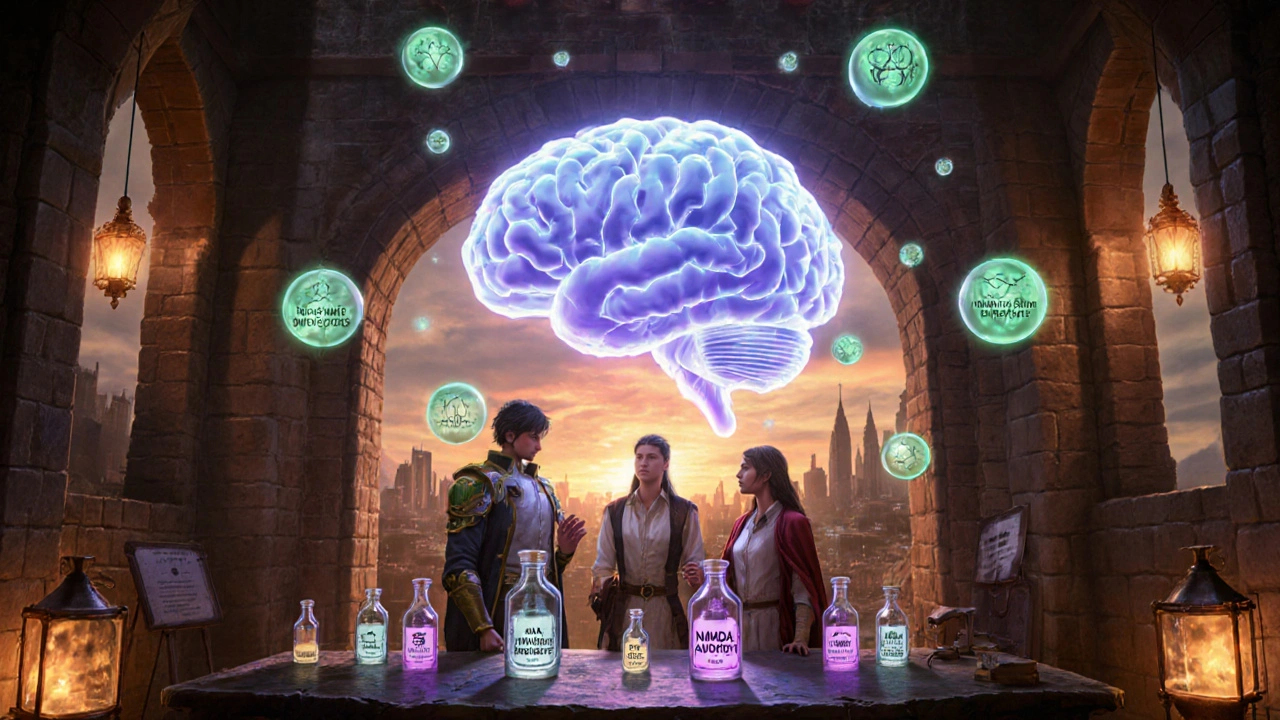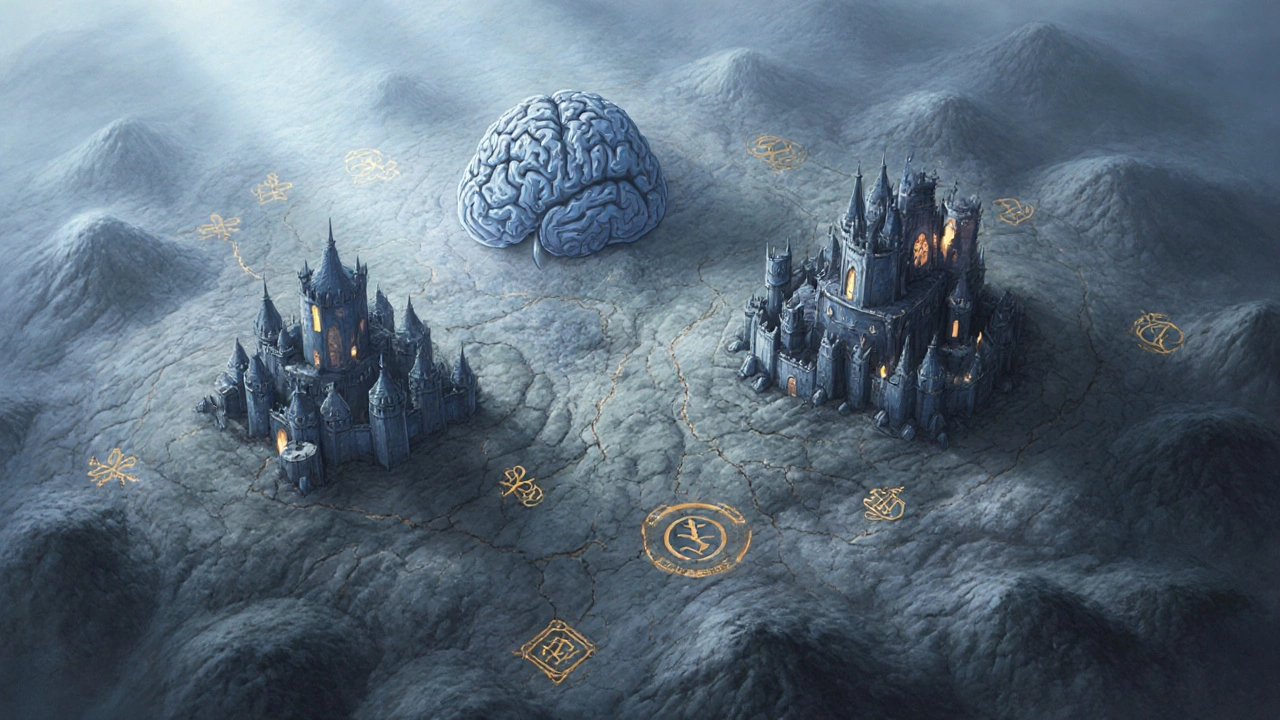Schizophrenia Brain Regions Visualizer
Explore how schizophrenia affects different brain regions and their neurotransmitter systems. Click on any area to learn more about structural changes, neurotransmitter imbalances, and clinical implications.
Prefrontal Cortex
Hippocampus
Temporal Lobes
Thalamus
About 1% of the global population lives with schizophrenia, a condition that reshapes thoughts, emotions, and behavior. Researchers have spent decades mapping the brain changes that underlie this disorder, and today we have a clearer picture than ever before.
Key Takeaways
- Schizophrenia involves a mix of dopamine, glutamate, and neurodevelopmental disruptions.
- Brain imaging consistently shows reduced gray matter in the prefrontal cortex and hippocampus.
- Genetic studies highlight dozens of risk genes, with DISC1 being a prominent example.
- Both dopamine‑blocking antipsychotics and glutamate‑targeting agents are being refined based on neural findings.
- Future work focuses on early detection through biomarkers and personalized treatment plans.
What is Schizophrenia?
Schizophrenia is a chronic psychiatric disorder characterized by hallucinations, delusions, disorganized thinking, and diminished emotional expression. It typically emerges in late adolescence or early adulthood and follows a complex, lifelong trajectory.
Brain Structure Abnormalities
Neuroimaging studies have repeatedly identified structural changes in several key regions:
- Prefrontal Cortex: Reduced gray‑matter volume correlates with impaired executive function and working memory.
- Hippocampus: Volume loss is linked to memory deficits and aberrant stress responses.
- Temporal lobes and thalamic relay nuclei also show subtle thinning, influencing auditory hallucinations.
These anatomical findings suggest that schizophrenia is not confined to a single spot but reflects network‑wide dysregulation.
Neurotransmitter Imbalances
Two chemical systems dominate current explanations.
Dopamine Hypothesis
Dopamine overactivity in mesolimbic pathways appears to trigger positive symptoms like hallucinations, while underactivity in mesocortical circuits relates to negative and cognitive deficits. Evidence comes from:
- Elevated dopamine synthesis capacity measured by PET scans.
- Clinical effectiveness of dopamine‑D2 receptor antagonists (e.g., haloperidol, risperidone).
Glutamate / NMDA Hypothesis
Glutamate, the brain’s main excitatory neurotransmitter, may be under‑functioning at NMDA receptors. This theory is supported by:
- Schizophrenic patients showing reduced cortical glutamate levels on magnetic resonance spectroscopy.
- Psychotomimetic effects of NMDA antagonists such as ketamine, which reproduce both positive and negative symptoms.
Genetic and Molecular Findings
Genome‑wide association studies (GWAS) have identified over 100 loci linked to schizophrenia risk. Among them, DISC1 (Disrupted-in‑Schizophrenia 1) stands out for its role in neuronal migration and synaptic formation. Other notable genes include:
- NRG1 (Neuregulin‑1) influencing myelination.
- COMT (Catechol‑O‑methyltransferase) affecting dopamine metabolism.
- GRIN2A governing NMDA receptor function.
Most risk alleles each contribute a tiny increase in probability, but together they shape a polygenic profile that interacts with environment.
Neurodevelopment and Synaptic Pruning
Adolescence is a critical window when the brain refines connections. Excessive synaptic pruning, possibly driven by complement cascade proteins like C4, may lead to the gray‑matter loss observed in MRI scans. This aligns with the neurodevelopmental hypothesis, which views schizophrenia as a disorder of faulty brain wiring that manifests later in life.

Insights from Brain Imaging
Modern imaging techniques provide a living map of disease processes.
| Modality | Typical Observation | Interpretation |
|---|---|---|
| MRI (structural) | Reduced gray‑matter volume in prefrontal and temporal regions | Supports neurodevelopmental and network‑disconnection models |
| fMRI (task‑based) | Blunted activation during working‑memory tasks | Links to dopamine deficits in the dorsolateral prefrontal cortex |
| PET (dopamine synthesis) | Elevated tracer uptake in striatum | Direct evidence for hyperdopaminergic state |
| MRS (glutamate) | Lower glutamate concentrations in anterior cingulate | Corroborates NMDA‑hypofunction theory |
Implications for Treatment
Understanding the neurobiology guides medication development.
- First‑generation antipsychotics mainly block D2 receptors, curbing positive symptoms but often causing motor side‑effects.
- Second‑generation agents add serotonin‑2A antagonism, improving negative symptom control for some patients.
- Glutamate‑modulating compounds (e.g., glycine site agonists, mGluR2/3 agonists) are in trial phases, aiming to address cognitive deficits.
- Early‑intervention programs now incorporate cognitive‑behavioral therapy and psychosocial support, reflecting the brain‑network view.
Future Directions
Researchers are converging on three promising avenues:
- Biomarker Discovery: Combining polygenic risk scores with imaging signatures to predict conversion in high‑risk youths.
- Precision Pharmacology: Tailoring drug choice based on individual neurotransmitter profiles measured by PET or MRS.
- Neuroprotective Strategies: Targeting complement‑mediated pruning or inflammation during adolescence to preserve synaptic integrity.
These paths could shift schizophrenia from a largely symptom‑based treatment paradigm to one rooted in biology.
Frequently Asked Questions
What causes schizophrenia?
Schizophrenia results from a blend of genetic risk, neurotransmitter disturbances (especially dopamine and glutamate), and abnormal brain development during adolescence. No single factor alone can explain the disorder.
How does dopamine contribute to symptoms?
Excess dopamine activity in the mesolimbic pathway is linked to hallucinations and delusions, while reduced dopamine in the mesocortical pathway is associated with flat affect and cognitive slowdown.
Can brain scans diagnose schizophrenia?
Currently no scan can definitively diagnose the illness. However, patterns like gray‑matter loss and altered dopamine synthesis help support a clinical assessment and may become diagnostic tools in the future.
Are there treatments that target glutamate?
Several glutamate‑modulating drugs are in PhaseII‑III trials. Early results suggest they may improve cognition and negative symptoms, but they are not yet widely available.
What lifestyle changes help manage the condition?
Regular exercise, adequate sleep, stress‑reduction techniques, and adherence to medication can lessen symptom severity. Social support and structured daily routines are also crucial.

Lydia Conier
August 29, 2025 AT 02:03Hey folks, great to see a deep dive into both dopamine and glutamate pathways – it really helps demystify the neurochemistry behind schizophrenia. I’d definitely suggest checking out the latest PET meta‑analysis from 2023; it shows that striatal dopamine synthesis capacity correlates with symptom severity across stages. Also, consider how early‑life stress can epigenetically modulate those neurotransmitter systems, something many studies are now uncovering. If you’re into neurodevelopment, the complement protein C4 story is a must‑read – it links synaptic pruning to gray‑matter loss. Keep the conversation going, and feel free to share any new pre‑print you’ve seen! (Typo alert: definately).
ruth purizaca
August 31, 2025 AT 09:36One must lament how most mainstream summaries reduce this intricate disorder to mere “dopamine imbalance” buzzwords, ignoring the nuanced interplay with glutamatergic signaling and neurodevelopmental trajectories. The pretentious veneer of recent reviews often obfuscates more than enlightens, presenting data without the requisite statistical rigor.
Shelley Beneteau
September 2, 2025 AT 17:10Appreciate the critique; indeed, the field benefits from more precise statistical reporting. Recent GWAS meta‑analyses, however, have begun to transparently present effect sizes and p‑values, aiding reproducibility while still highlighting the polygenic nature of risk.
Sonya Postnikova
September 5, 2025 AT 00:43Love how you pulled together the PET data and C4 findings! 😊 It’s exciting to see such interdisciplinary links. Also, remember that lifestyle factors like regular exercise can modestly boost glutamate turnover, which may complement pharmacotherapy.
Anna Zawierucha
September 7, 2025 AT 08:16Oh yeah, because a single gene totally explains everything. 🙄
Mary Akerstrom
September 9, 2025 AT 15:50Thanks for sharing all these resources i think its really helpful for anyone trying to understand the basics of schizophrenia neurobiology i especially like the clear tables and the summary of imaging findings
Delilah Allen
September 11, 2025 AT 23:23Indeed, the tables are quite informative; however, one must also consider the limitations inherent in cross‑sectional imaging studies-sampling bias, medication effects, and the ever‑present confound of comorbid conditions, which collectively muddy the interpretative waters; thus, a cautious approach is warranted, lest we overstate causal inferences.
Nancy Lee Bush
September 14, 2025 AT 06:56Wow, that was a sharp take! 😂 But seriously, the genetics are polygenic, not monogenic, and each variant adds only a tiny increment to risk. It’s the cumulative load that matters, especially when intersected with environmental stressors.
Dan Worona
September 16, 2025 AT 14:30Ever wonder why the big pharma pushes dopamine blockers while ignoring the silent agenda of controlling thought patterns? The whole system seems orchestrated to keep us compliant, not cured.
Chuck Bradshaw
September 18, 2025 AT 22:03While dopamine antagonists reduce positive symptoms, they do little for cognitive deficits, which are better correlated with prefrontal glutamate dysregulation. Ignoring this leaves a huge therapeutic gap.
Howard Mcintosh
September 21, 2025 AT 05:36Gotta say, that sounds like a wild theory, but the data does show that dopamine blockers can cause motor side‑effects, which some interpret as a form of control. Still, the primary goal is to reduce hallucinations, not to limit free thought.
Jeremy Laporte
September 23, 2025 AT 13:10Hey Chuck, you nailed the gap in treatment. Many clinics now incorporate cognitive remediation alongside meds to target those prefrontal deficits.
Glenn Gould
September 25, 2025 AT 20:43Just read a new study on synaptic pruning-turns out the complement cascade is even more active than we thought, especially in teens who later develop psychosis. Crazy stuff!
Julien Martin
September 28, 2025 AT 04:16The findings suggest a paradigm shift: by synergizing immunomodulatory agents with existing antipsychotics, we could potentially mitigate excessive pruning. This integrative approach aligns with a systems‑level model of schizophrenia.
Lolita Rosa
September 30, 2025 AT 11:50It is absolutely astounding how the narrative surrounding schizophrenia has become a battlefield for competing ideologies, each eager to claim the mantle of the true guardian of public health. The scientific community, armed with rigorous methodologies, strives to unravel the tangled web of genetics, neurochemistry, and environmental interactions. Yet, every breakthrough is greeted by alarmist headlines that paint a dystopian picture of a society overrun by “mind‑control” drugs. There is a genuine concern that powerful interests might exploit these findings to further marginalize vulnerable populations. Moreover, the historical mistreatment of patients fuels a deep‑seated mistrust that cannot be dismissed lightly. At the same time, we must acknowledge that many patients have experienced tangible improvements in quality of life thanks to antipsychotic medications. The challenge lies in balancing safety, efficacy, and autonomy, all while navigating a fraught political landscape. National policies should prioritize funding for early detection programs rather than punitive measures. It is also crucial to invest in community‑based psychosocial interventions that empower individuals. Critics who label all research as a conspiratorial agenda do a disservice to those who labor tirelessly in labs worldwide. Conversely, supporters who uncritically endorse every new drug without scrutiny risk repeating past errors. The path forward demands transparent communication between clinicians, researchers, and the public. We must celebrate incremental advances while remaining vigilant against the co‑optation of science for ulterior motives. Ultimately, a compassionate, evidence‑based approach will serve humanity far better than cynicism or blind propaganda.